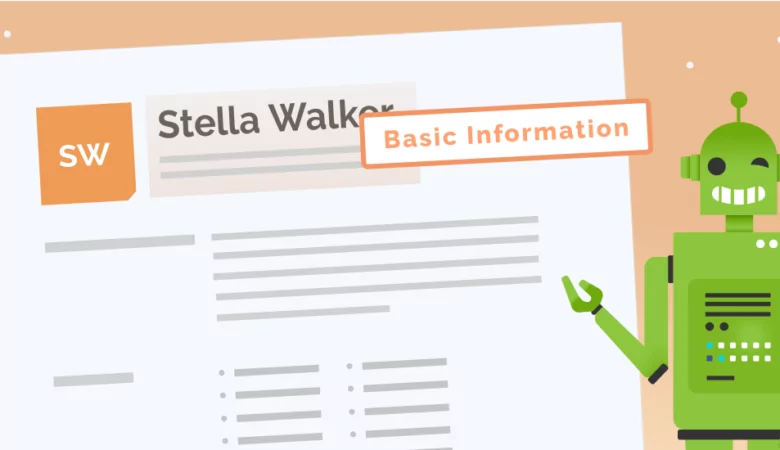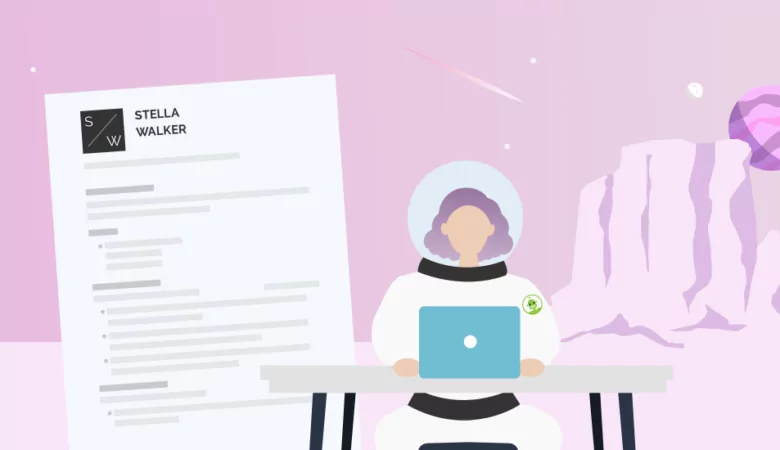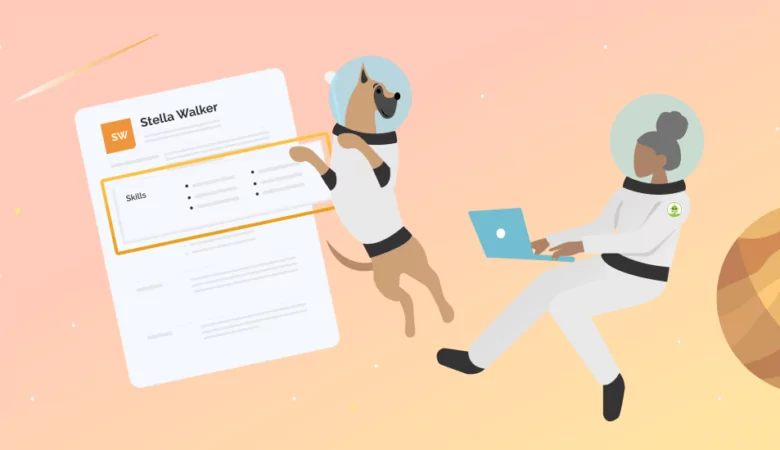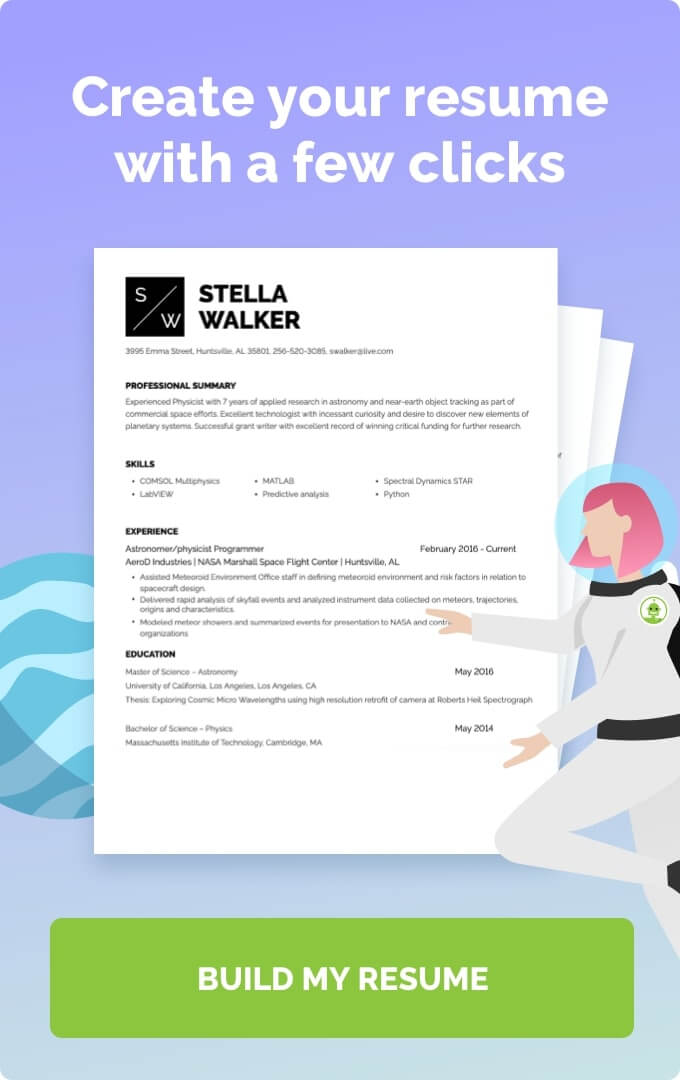In this guide, we’ll offer resume samples for your first job, along with detailed notes on the best format to use, what to include, what to avoid, and organization tips to help you wow potential employers and show them that you’re the best fit for the position.
Table of Contents
- – Introduction
- – The Best Resume Format For No Work Experience
- – The Reverse Chronological Resume Format With No Work Experience
- – The Functional And Combination Resume Formats With No Work Experience
- – What To Put In The Resume Summary Statement
- – Specific Resume Help For Specific Circumstances
- – How To Apply For A Job That Requires Experience
- – The Final Word On The Perfect Resume For Your First Job
 Introduction
Introduction
Here’s the good news: while you may not have work experience, you’ve probably amassed plenty of life experience and skills that make you a qualified candidate.
The resume writing process for you is all about identifying and highlighting what you have to offer that’s relevant for each position. You can draw from your education, your volunteer work and community involvement, even your hobbies and personal interests. We’ll help you identify which resume format is best when you have no work experience, and understand how to make the most of the experience you do have to gain your first adult job.
 The Best Resume Format for No Work Experience
The Best Resume Format for No Work Experience
There’s more than one type of resume. There are three main resume formats: chronological, functional, and combination. We’ll go into greater detail about working with each format below, but in case you’re not clear on the difference between them, let’s briefly review:
- The reverse chronological resume format emphasizes work experience, which is listed in reverse order, starting with the most recent position and finishing with the oldest. Skills are listed as bullet points, usually above the experience section.
- The functional resume format (also called the skill-based resume format) puts more emphasis on the skills you’ve developed. The experience section, if present, can be arranged to highlight your most relevant experience.
- The combination resume format (also called the hybrid resume format) puts roughly equal emphasis on skills and experience. Usually, skills are listed before experience.
When creating a resume for your first job, it’s important to choose the right format to highlight your talents and skills, particularly with limited or no experience.
There’s not one specific resume template that is best for no work experience.
The most appropriate format will depend on your unique circumstances.
Should You Use a Reverse Chronological Resume Format?
The chronological resume format is the most recognizable and common resume format, and the one that hiring managers typically expect to see. It’s with good reason: this format is easy to read, informative, and provides a good overview of who you are and what you’ve been doing in your career.
The catch for first time job seekers? The chronological resume format is generally best suited to individuals with straightforward work experience that relates directly to the position that is being offered.
Even without a traditional job history in the field, you may still choose to use this format. If you have commensurate experience via other experiences such as volunteering or research, the chronological resume format may still be appropriate for you.
However, if you do not have any relevant experience, this resume format may not be the strongest way to indicate why you’re a good fit for the job. In cases like these, you might consider an alternative resume format, such as the functional or combination resume format.
If you have little relevant experience,
a functional resume format will allow you to highlight
the transferable skills you do have.
In the following sections, we’ll discuss more specific tips for each of these resume formats so that no matter which format you choose, you can set yourself up for success.
Chronological Resume Format: Review
- The three main resume types are reverse chronological, functional, and combination (also called hybrid). Which one you choose to use to apply for your first job will depend on your unique circumstances.
- The chronological resume format is the most traditional and expected resume type.
- Even without traditional work experience, commensurate experience such as volunteering or research could be listed on the chronological resume format.
- If you don’t have any relevant experience, consider using a functional or combination resume format instead of the chronological resume format.
 The Reverse Chronological Resume Format
The Reverse Chronological Resume Format
with No Work Experience
Since the reverse chronological resume is typically what hiring managers expect to see, it’s worth considering whether or not this format is appropriate for you.
When To Use a Reverse Chronological Resume
Without Work Experience
Believe it or not, a lack of work experience doesn’t necessarily preclude the use of the chronological resume format. If you have commensurate experience that comes from sources other than traditional jobs, it may still be an appropriate choice.
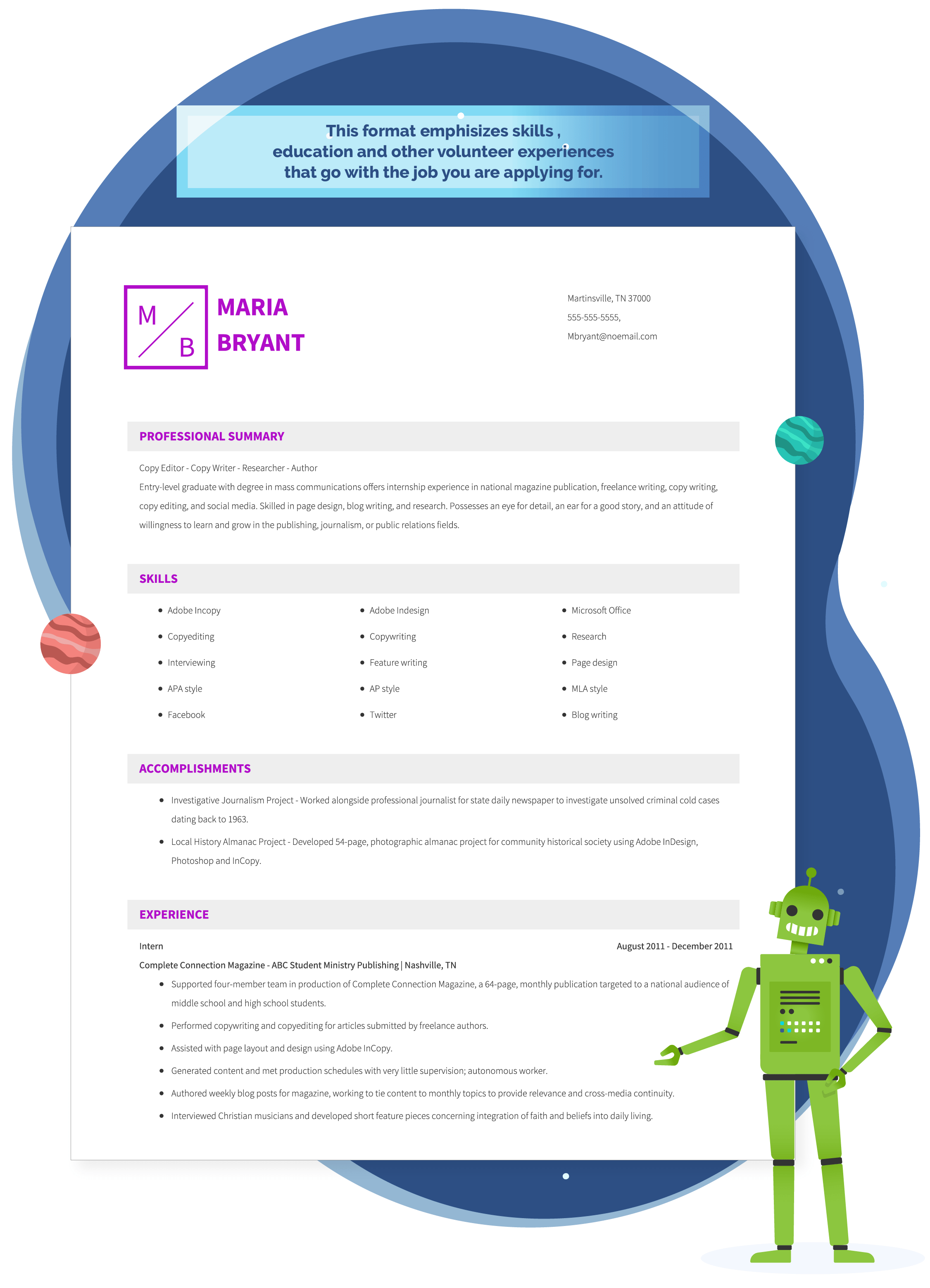
Here are just a few examples of non-work experience that you could list on a chronological resume format:
- Soft skills:
If you have skills in teamwork, time management, customer service, communication, and project management, add them to your resume when relevant to the position you’re applying for. - Volunteer experience:
Even unpaid volunteering positions can demonstrate specific skills and experience that will help you succeed in a job. - Apprenticeships/internships:
If you studied under someone in your desired field or completed a summer internship at a company related to the job you’re applying for, it warrants a spot in the experience section of your resume. - Research experience:
If you took part in a research project that relates to the field you’re applying in, this experience could demonstrate that you have expertise or skills that could make you an asset to the position.
Though these may not be traditional jobs, you should still follow appropriate work experience formatting on your resume. For each entry, you’ll want to include the following information:
✓ The name of the organization or project
✓ The location
✓ Your role and title, if applicable
✓ The dates of your experience
✓ Any specific achievements of note
For example, a volunteering entry on your resume might look like this:
| ✓ Volunteering Entry Example |
|---|
|
Girl Scouts of America Northwest Chapter, Seattle, WA Volunteer Activities Coordinator (January 2017-April 2019)
|
Formatting the Education Section if You Have No Experience
If you’ve decided to use the chronological resume format with limited or no work experience, the education section of your resume is going to play a key role in demonstrating that you have what it takes to succeed at the job. A well thought out and formatted education section can help you sell yourself as the perfect candidate!
One of the first things you’ll need to consider when formatting your education section is placement. The education section generally appears in one of two places on a chronological resume: either before or after the experience section. For job seekers who are recent graduates, and who have little to no work experience, it’s best to place your education section above your work experience.
Does your education history strongly demonstrate that your studies directly related
to the type of job you’re pursuing? If so, be sure to place your education section
at the top of your resume, right after your summary and skills.
Emphasizing your schooling by listing it more prominently has two key benefits. First, it acts as an explanation of why you don’t have much job experience. Second, it shows the employer that you have put in time and effort that qualifies you for the position.
Be sure to include the following information in the education section:
✓ The degree or degrees you received. If you are still in school,
list the degree as “in progress.”
✓ Your course of study (major and minor).
✓ The dates you attended, with a note about anticipated graduation date if you’re still in school.
✓ The name of the school.
✓ The school’s location.
Adding highlights from your academic career can make your resume more robust. Focus on things like honors, coursework, or even your GPA if it’s an impressive one (3.5 or above is a good rule). Choose achievements that spotlight specific capabilities or skills that relate to the position you’re applying for.
So, for example, a visual artist’s education section, placed above the experience section, might look like this:
| ✓ Visual Artist Education Entry Example |
|---|
|
BFA Illustration (2014-2018) Pratt Institute
|
If you have any continuing education courses or trainings related to your education,
you can include them too. Format them in the same way,
but include the course title, instructor, organization, and dates.
Reverse Chronological Resume Format: Review
- If you have commensurate experience that comes from sources other than traditional jobs, the chronological resume format may be the best choice for you.
- While your experience may not be from traditional jobs, you should still format each listing as if it were a traditional job on your resume.
- The education section can help show that you’re prepared to work in the field, so consider listing it above the experience section.
 The Functional and Combination Resume Formats with No Work Experience
The Functional and Combination Resume Formats with No Work Experience
If your work experience either isn’t appropriate or does not make a strong showing on your resume, then the chronological resume format may not be the best choice for you. However, this doesn’t mean you have to give up on a prospective job.
Instead, use the functional or combination resume format to showcase the skills and talents that make you a desirable candidate.
The Functional Resume Format Without Work Experience
The functional resume, also referred to as a skill-based resume, is primarily dedicated to showcasing the skills you’ve developed that are relevant to the job you’re applying for. This resume format puts little to no emphasis on work experience.
The idea behind using the functional resume format?
You can prove that while you don’t have relevant work experience,
you possess skills that make you a good fit for the position.
What Is Included in the Functional Resume Format?
With the functional resume format, you’ll want to include much of the same information that would be in a traditional chronological resume. However, there will be some important differences in terms of order and emphasis.
Here’s what you’ll want to include:
✓ Basic information:
This section goes at the very top of the resume and includes basic details like your name, professional title, and your contact information.
✓ Summary statement:
A brief summarization of who you are professionally and what qualities/skills you possess that make you a good candidate.
✓ Skills:
This is the real meat of the functional resume format. Emphasize that your skills make up for your lack of experience. For example, if you were applying for a customer service position, you might want to emphasize your skills in typing, computer programs, and your ability to work well with others.
✓ Experience:
Unless you have zero experience, you should still include an experience section. Even if the position is not relevant to the position offered, proving that you’ve been employed in the past can show that you are reliable and trustworthy. Be sure to include the company, your job title, and a summary of responsibilities and duties that could apply to the job position you want.
✓ Education:
The education section will include the school or schools you attended, degrees received, and the dates you attended. Unless you didn’t go to college, high schools are not necessary. Once again, the education section may appear either above or below the experience section; strongly consider which placement will put you in a more positive light.
✓ Additional sections:
Beef up your functional resume with added sections that show how accomplished you are, including certifications, professional memberships, achievements/awards, and volunteer work.
The Combination Resume Format Without Work Experience
The combination resume format, also referred to as a hybrid resume format, allows you to mix aspects of the chronological format and the functional resume format. In this case, you are going to put slightly more emphasis on skills, while still showing your experience.
What Is Included in a Combination Resume Format?
Much of the same information appears on a combination resume that appears on both the functional and chronological resume formats, including:
✓ Basic information:
This information should be positioned top and center on every resume type: your name, professional title, and contact information.
✓ Summary statement:
A brief summary of who you are and what qualities make you a desirable candidate.
✓ Skills:
This is where you showcase the skills you have developed that align with the role you’re targeting.
✓ Experience:
Include a separate entry for each experience/employer listing, being sure to note company name, your title, and a description of your key roles.
✓ Education:
Include the school’s name, degree or degrees attained, and the dates you attended. Once again, unless you didn’t go to college, high school is not necessary.
✓ Additional sections:
Make your resume extra special by showing any other information that can show that you are going to be a stellar employee. You may consider adding sections like certifications, publications, memberships, and so on.
Choosing Skills for a Functional or Combination Resume Format
Since skills are a major focal point on the functional and combination resume, it’s important to really make the skills section section shine on these respective formats. What skills should you list for maximum impact? First, understand the difference between soft skills and hard skills.
Soft skills are more universal skills, and are often transferable from one role to another. However, soft skills are generally difficult or impossible to quantify. While important, they can also be over-used to compensate for lack of experience or relevant qualifications. Be sure you only include soft skills you actually possess, and have a way to demonstrate those skills: on-the-job experiences, projects, or achievements in which you successfully used your soft skills.
| ✓ Soft Skills Example | |
|---|---|
|
|
Hard skills, on the other hand, are technical skills. They tend to relate to specific job roles or responsibilities. Often, there’s training required to be certified for a particular hard skill, or for some level of proficiency with the skill. Hard skills are typically more impressive on a resume because they’re specific and measurable, and because they show that you have the particular experience and capability needed for a role.
| ✓ Hard Skills Example | |
|---|---|
|
|
Second, take a careful look at the job listing. What skills does the job require? Some job listings make this very obvious, with a list of specific required skills. However, with some job listings, you may have to read between the lines of the job description to figure out what skills the employer is looking for in an employee.
Need a starting point? Here are some common skills that employers are looking for:
- Communication skills:
Are you a whiz at writing effective emails? Are you excellent at delivering presentations? Include skills that indicate these strengths in your resume. - Computer skills:
More and more, specific computer skills are required for job positions. So if you don’t have experience, you can help make up for it by mentioning your prowess with various computer programs or technical skills. For example, if you have mastered the entire Google suite of tools, or have 10 years’ experience with Photoshop, be sure to mention it on your resume. - Customer service skills:
Being a people person can be an asset to a variety of different job positions. Be sure to call these skills out! - Management skills:
Not everyone is skilled in delegating and working well with others. If you’re a skilled manager, this can help you stand out for a variety of positions. - Problem solving skills:
Any position will come with challenges, so if you possess great problem solving skills, mention it on your resume. - Time management skills:
It’s been said that the majority of success is simply showing up. Being able to manage your time effectively and turn in assignments on time is a valuable skill for potential employers to see.
Of course, it’s important to note that you shouldn’t just list skills that the employer wants unless you actually possess them. You need to be honest when listing your skills so that you can find a job that is actually a good fit.
Confused about what skills you actually have?
Take stock of your strengths in school, clubs, and in computer programs.
Sometimes, asking friends or relatives what they consider your strengths to be
can also offer a good starting point to determine your strongest skills.
Functional or Combination Resume Format: Review
- If you lack experience, the functional or combination resume format can help you showcase the skills and talents that make you a desirable candidate.
- The functional resume format is a good choice when you have very little or no experience but have skills that qualify you for the job.
- The combination resume format is a good choice when you have a little experience, but either it may be in an unrelated field or your skills are a stronger indication of why you’re a good fit for the job.
- Since skills are a focal point on both of these resume types, it’s important to take special care when formatting this section and to list skills specifically required by the employer.
 What to Put in the Resume Summary Statement
What to Put in the Resume Summary Statement
If your resume were a feature film, then the summary statement would be the movie preview. It’s a short teaser that is designed to create interest and entice whoever is viewing your resume to want to see more.
The resume summary statement is typically the deciding factor
on whether or not the person reading your resume will keep reading or not.
The summary statement is a 3 to 6 sentences at the top of your resume, just below your name and contact information. Since the summary statement is one of the first things a hiring professional will read, the pressure’s on to create a compelling statement that commands attention.
Like the rest of your resume, the summary statement should always be tailored to be appropriate for the specific job you are targeting.
Summary Statement With No Work Experience
If you don’t have work experience, you can’t write something like “professor with 12 years’ experience” in your summary statement. However, you can emphasize what you can offer that makes you a perfect candidate for the job offered.
Get smart with your descriptive words. For example,
you can use terms like “results-driven” or “detail-oriented” to describe yourself,
and accurate, specific adjectives to describe your skills.
Here are some things to consider including in the summary statement:
- Education:
Include a mention of your education as it relates to the job. For example, if you’re applying for a job at an investment firm, mention that you’re a finance graduate. - Skills:
Mention specific skills that are requested in the job listing that you possess, offering information about what value you can bring to the position. - Accomplishments:
If you have specific impressive accomplishments that might make you appealing for this role, be sure to mention them. - Keywords:
In general, you want to show an employer that you’ve carefully read their listing and know what they’re looking for. Try to fit in specific keywords they’ve used in the job listing. - A reflection of what follows:
Be sure the summary statement is an accurate reflection of the resume itself. Often, it’s easiest to write the summary statement after writing your resume, so that it is an accurate reflection of what is in the rest of the document.
On the other hand, you’ll want to avoid including the following in your resume summary statement:
- Explanations:
You don’t need to explain your lack of experience in the summary statement. Keep things upbeat and focus on what you have to offer versus what could be perceived as a strike against you.
Many job seekers feel they need to state that they are interested
in obtaining XYZ position in their summary statement; however,
that’s already a given since you are applying for the role.
No need to restate the obvious.
- Vague skills:
Don’t mention general, vague skills like “self-starter” or “multitasker” without context, because they can sound trite. Instead, make sure to mention specific skills that make sense for the job and put them to work with an example.
Examples of Summary Statements and How to Tailor Them
Let’s illustrate the summary statement with a few examples. For example, you’re looking for your first job out of school and you want to work at a brokerage firm that is looking for a stock research assistant. Your summary statement might look like this:
| ✓ Research Assistant Summary Statement Example |
|---|
|
“Detail-oriented Finance graduate passionate about identifying opportunities for intelligent and calculated investments. A highly self-motivated swing trader, who is proficient in a range of trading-related technologies including stock screeners, brokerage platforms, and paper trading modules.” |
But if you were applying for a brokerage firm customer service position within the same sector, you might edit the summary statement to read like so:
| ✓ Customer Service Summary Statement Example |
|---|
|
“Finance graduate passionate about educating others on how to manage finances and maximize wealth. Effective at conveying stock market knowledge in easy to understand terms to consumers. Knowledgeable about swing trading, day trading, and long term investing.” |
Summary Statement With No Work Experience: Review
- The resume summary statement is your chance to entice whoever is viewing your resume, so be sure to showcase your top skills and selling points!
- Read the job description carefully and try to fit in a few keywords from the listing in your summary statement.
It’s very important to use the right keywords
in order to bypass an ATS (Applicant Tracking System),
which most companies use. You want to use the same keywords
in your resume that the company used in the job description.
- Be specific, concise, and informative. Make sure your summary statement accurately reflects the information contained in your resume
- Tailor your summary statement to each job you’re applying for to make the greatest impact.
 Specific Resume Help for Specific Circumstances
Specific Resume Help for Specific Circumstances
After you’ve been in the professional workforce for a few years, you will begin to amass experience to list under the work experience heading on your resume. But at the beginning stages of your career, you might be at a loss for what to list.
Happily, even if you haven’t been active in the workforce, chances are high that you have gained some valuable (and employable) skills through your education and everyday life.
So if you’re a newbie to employment–we’re talking to you, high school students, college students, and recent grads–here are some specific tips for your unique circumstances.
High School Students
If you’re a high school student, chances are this is your very first resume. While you may not have held an official job before, it’s quite possible that you’ve gained experience in various informal ways, including:
- Neighborhood jobs including babysitting, pet sitting, shoveling snow, or mowing lawns.
- Extracurricular activities such as clubs or sports you take part in at school.
- Volunteer positions you’ve held.
- Internships at school or at an office.
For new graduates, your resume is about sharing skills
and milestones that prove you will be a good employee.
A resume template for entry level jobs can help you you can list these experiences to show a potential employer that you have a good work ethic, are reliable, and trustworthy–which are key traits for entry level positions.
If you do have some experience like the situations detailed above, you can list them under your work experience section. For instance, if you are applying for an entry level sales position at a pet store, you might list your experience this way:
| ✓ High School Student Experience Example |
|---|
|
Pet Sitting Services 2018-Present
|
By showing this experience on your resume, you’ve demonstrated that you’re a self-starter, are able to adhere to a schedule, and that you know a thing or two about animal care that could translate well to a retail position in a pet store. For the potential employer, this shows that you may have an appropriate knowledge base to work for them, even though you’ve never held an official job.
College Students or Recent College Graduates
If you’re a college student or recent graduate, chances are you’re looking for more serious positions aligned with your chosen career path. However, you are in a unique, somewhat tricky position: you have focused on an industry or sector through your studies, but haven’t yet gained a lot of experience. What to do?
First, decide which resume format you might like to use. Your resume needs to be a bit more formal and advanced than a resume for a recent high school graduate. Think about how you can leverage your education, experiences, and skills to show employers that you’re a great fit for the job.
Class experience, special projects, volunteer work,
summer jobs, and community involvement
are all great ways to share your skills, capabilities,
and accumulated experience.
For example, if you have just graduated, think about any experience you gained while in school that could make you a desirable candidate. Examples might include:
- An internship
- Volunteer positions
- School groups related to the field
- Education or volunteer travel
- Summer jobs and part-time jobs
- Teaching or research assistantship
For instance, if you had a part time student job at the computer center and had an internship at a local PR firm, these would be experiences that warrant listing in the chronological format.
If you do not have specific experiences to list but have gained relevant skills through your studies, you will want to consider either the functional or combination/hybrid format.
Also, consider the placement of your education section on this type of resume. For recent graduates, placing the education section above the experience can show employers that you’ve been working hard to learn the necessary skills and knowledge to break into your field.
Additional Tips for College Students or Recent Grads
- If you’re still a student, list the school you’re attending, the anticipated date of graduation, your major, and the type of degree you’re pursuing.
- Remember: even if your work experience isn’t within the desired field, it can still inform potential employers about your work ethic and reliability. Your experience as a server may have some value on your resume.
- Have you received awards, scholarships, or honors? Don’t be shy about mentioning them.
 How to Apply for a Job that Requires Experience
How to Apply for a Job that Requires Experience
True, most employers want to see work experience. But there will always be situations where candidates who are qualified may not have had a traditional trajectory in their professional lives. A lack of traditional work experience does not necessarily mean you are unqualified to apply.
Don’t sell yourself short on experience. If you’re a job candidate applying
for a position that requires 5 years of experience, and you have a Bachelor’s degree and 2 years of experience, chances are high that you will qualify.
Higher education can stand in for actual years of job experience.
First, consider that even if your experience isn’t traditional–i.e. traditional paying jobs within the sector–it may still add value to your resume. Volunteer positions, research, group collaborations, even a personal blog related to the job could qualify as experiences.
Using the functional resume format or the combination/hybrid resume format may also be helpful. They allow you to emphasize the skills that could qualify you for the position while putting less emphasis on your work experience.
Additionally, listing your education more prominently on your resume can be helpful, as it shows that you have been working hard to gain expertise in the sector even if you haven’t been logging hours in an office.
Finally, remember that there’s no need to apologize for your lack of experience. Everyone has different life circumstances. Rather than writing an apology letter, write an upbeat cover letter. Resist the urge to apologize for your lack of experience; instead, be proactive and confident in pointing out the strengths that make you a qualified candidate.
 The Final Word on the Perfect Resume for Your First Job
The Final Word on the Perfect Resume for Your First Job
No doubt about it: finding a job without work experience can feel intimidating.
However, it’s important to remember that even without traditional work experience, the real-life experience that you’ve amassed matters. Whether through your education, non-work experience, volunteer activities, or everyday life, you can describe and use your experience to write an effective and compelling resume.
To position yourself for success, it’s important to be extremely tactical about how you organize your resume, from the format you choose, to the order of different sections, to the skills you showcase.
Even without work experience, an expertly organized and thoughtfully prepared resume can get the attention of hiring professionals…and could lead to the job offer of your dreams!


